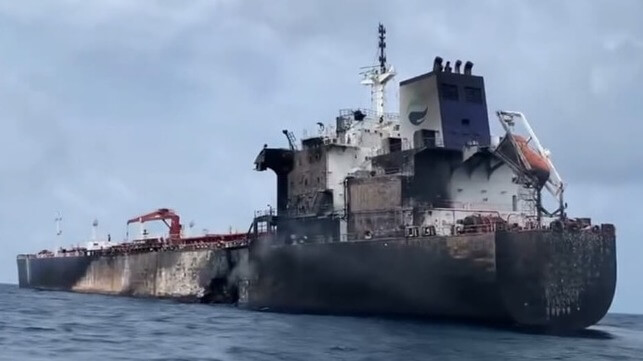Salvage Team Surveys Fire-Damaged Hafnia Product Tanker

Hafnia is working with the officials in Malaysia and Singapore to develop a salvage plan for its heavily damaged product tanker Hafnia Nile. Initial surveys they reported have revealed a “localized seepage,” with the company telling the Maritime and Port Authority of Singapore that there are light oil sheens around the vessel and that it will arrange for containment and clean-up.
The 74,000 dwt vessel remains at sea approximately 25 nautical miles north of Malaysia and more than 50 nautical miles from the mainland of Singapore. An additional tug with deep-sea tow capability arrived at the vessel yesterday, July 23. It is in addition to four tugs that were sent to stop the vessel from drifting. The tug also has transfer equipment and can assist with the oil seepage.
In a statement to Reuters, Hafnia said that salvage teams have been able to begin assessing the damage to the vessel. They reported finding damage to the engine room from the impact and fire. Images of the vessel show a hole in the hull on the port side as well as heavy scorching from the fire after the impact on July 19.
Spain’s Cepsa confirmed to S&P Global Commodity Insights that it owns the cargo which is being reported to be 300,000 barrels of naphtha that had been bound for Japan. With the vessel heavily damaged, the expectation is that a ship-to-ship transfer will be arranged.
The MPA said it is in discussions with Hafnia on a safe location to transfer the naphtha cargo. They also expect the vessel to be towed after a salvage plan is approved by the MPA. As the flag administrator of the vessel which was built in 2017, the MPA is also involved in the investigation into the collision with the Ceres 1, a Chinese-owned VLCC.
Malaysian officials reported yesterday that the crews of both vessels were safe and that they had ended the search efforts. They are focusing on the circumstances of how the two vessels impacted near the eastern end of the Singapore Strait. They are detaining the Ceres 1 and two tugs that had removed the tanker from the area of the incident.
